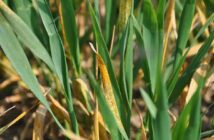Winter barley still has a place for black-grass control but good establishment is essential to keep the crop competitive and the black-grass out.
Harvest 2016 was disappointing for winter barley with ADAS reporting yields 9-12% below average and relatively poor quality to boot. But 2017 will be a different harvest, so it is still worth investing in the crop to achieve good weed control and good yields. Barley can help spread workload and is more competitive than wheat, as Colin Lloyd of Agrii explains.
“On black-grass land that’s not horrendous, if you want to start drilling early opt for barley. With wheat, you can’t go in and drill at the end of September on bad black-grass land, you have to drill later. But there is the option to use winter barley for the earlier drilling slot, particularly if it is a conventional or hybrid 6-row,” says Mr Lloyd. “In trials drilled on 1st October, there was a five-tonne difference between hybrid barley and wheat because the barley could compete with the black-grass and the wheat couldn’t. But on the same land drilled three weeks later the wheat yield was much better because of less black-grass but the barley dropped because it couldn’t cope with the late drilling date.”
Barley is more competitive than wheat but growers need to make sure it gets the chance to show off its advantages, asserts Darren Adkins of Bayer. In black-grass situations post-emergence weed control is limited to the ACCase group (“Fops, Dims and Dens”) which suffers from very widespread resistance. Because of this everything needs to come from a competitive crop paired up with a strong residual programme.
“Do everything you can to make a good, fine seedbed so the barley establishes well so the crop can move faster in the autumn and early spring and out-compete black-grass – a high seed rate will help here as well,” says Mr Adkins. “There are several options for varieties but whichever barley you grow it needs to get up and away well. Apart from a competitive crop, controlling problem grass weeds pretty much depends on the pre-em as there aren’t any reliable post-emergence contact herbicides for black-grass.”
A full rate application of Liberator (flufenacet + diflufenican) is the backbone of the programme with the option to add pendimethalin or more diflufenican boosting performance.
“With winter barley it’s really important to apply at the true pre-em timing for better control and crop safety,” continues Mr Adkins. “Give barley the crucial time to get far enough ahead of any weeds that it remains clean and has the best chance of yielding well next summer.”
For more information on the right conditions for Liberator applications, there are articles and videos at www.bayercropscience.co.uk



